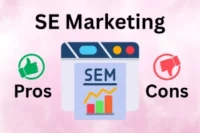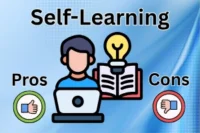What is Content? Guide to Understanding Its Role
Published: 10 Oct 2025
Have you ever wondered, “What is content?” Content is anything that communicates a message or information to an audience. It can be text, images, videos, or even audio. In this article, we will explore what content means, why it is important, and the different types of content you can create and use.
So guys, let’s waste no time and get this show on the road!
What is Content?
Many people think content and information are the same, but they are not. Here is the difference, which will give you a clear idea of what is content and what is information.
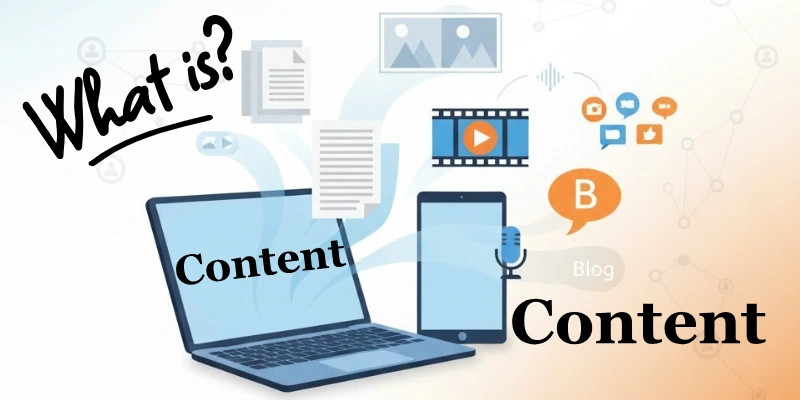
- Information: This is just plain facts, like numbers or data. For example, “The temperature today is 75°F” is information. It gives you a fact without any context or explanation.
- Content: This is information that tells a story or gives meaning. It turns plain facts into something more engaging and useful. For example, a blog post explaining how the 75°F temperature affects your outdoor activities, what to wear, and why the weather is like this is content. It takes the basic information and adds context, interpretation, and value.
So, guys’ information is basically raw data, and content is the information that tells a story or gives us meaning.
Purpose of Content
The purpose of content is to communicate and engage with an audience. Here are some key reasons why content is important:
- Educate: Content helps to teach and inform people about different topics.
- Engage: It captures the audience’s interest and keeps them involved.
- Inspire: Good content can motivate and encourage people to take action.
- Entertain: It can provide enjoyment and amusement.
- Build Trust: Consistent and quality content can establish trust and credibility.
Content serves multiple purposes, making it a powerful tool in communication and connection.
Types of Content
The content section’s purpose suggests that content serves various purposes, and altering the purpose can also alter the format, style, and tone of each piece.
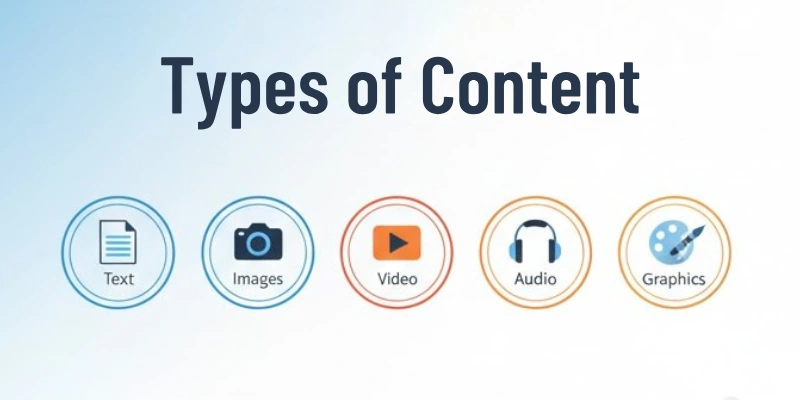
Exactly yes!!! There are different forms of content; each has its own unique features. Therefore, I will list all of them here:
Text
Text content includes articles, blog posts, and social media updates. It is written words that convey information or tell a story. Text is easy to create and can be very detailed.
Images
Images include photos, illustrations, and graphics. They can capture attention quickly and convey messages visually. Images are great for making content more engaging and easier to understand.
Audio
Audio content includes podcasts, audiobooks, and music. It is spoken words or sounds that can be listened to. Audio content is useful for people who prefer listening over reading or watching.
Videos
Videos combine moving images and sound. They can be short clips, tutorials, or full-length films. Videos are very engaging and can explain complex topics easily.
Interactive
Interactive content includes quizzes, polls, and interactive infographics. It allows the audience to interact and participate. This type of content is great for engagement and learning.
New Formats
New formats are emerging types of content, like virtual reality (VR) and augmented reality (AR). They give you a very realistic experience and keep you engaged. These formats are still developing and offer exciting possibilities for the future.
Who Makes Content?
Content is created by various people and organizations, each with their own goals and expertise. Here are the main creators of content:
Individuals
- Bloggers: They write personal or professional blogs about topics they are passionate about or knowledgeable in.
- Social Media Influencers: They create posts, photos, and videos to share on platforms like Instagram, YouTube, and TikTok.
- Freelance Writers and Designers: They create written articles, graphics, and multimedia content for various clients.
Businesses
- Marketing Teams: They create content to promote products, services, and the brand. This includes blog posts, social media updates, videos, and more.
- Content Creators: These are professionals hired specifically to produce content, like copywriters, graphic designers, and videographers.
Organizations
- Nonprofits: They create content to raise awareness about their causes, attract donations, and engage with their communities.
- Educational Institutions: Schools, colleges, and universities create content for educational purposes, such as articles, videos, and interactive media.
Media Companies
- Journalists and Reporters: They write news articles, produce videos, and create multimedia content to inform the public about current events.
- Entertainment Producers: They create movies, TV shows, music, and other entertainment content.
Government Agencies
- Public Relations Teams: They create content to inform citizens about policies, programs, and public services.
Key Points to Remember
- Content can be text, images, videos, audio, or a combination of these.
- Content Creators use their skills to engage, inform, entertain, or persuade their audience.
- The Purpose of Content varies, including marketing, education, entertainment, and information sharing.
Steps to Make Content
Creating content involves several important steps. Here’s a simple guide to help you understand the process:
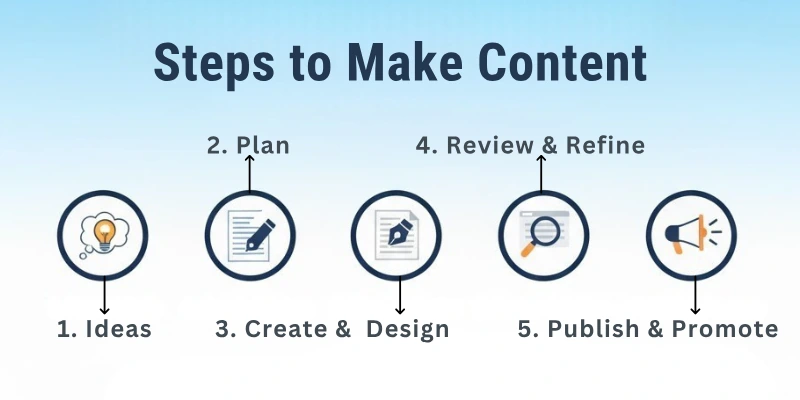
1. Ideas: Think of What to Make
- Brainstorm: Come up with different ideas for your content. Think about what topics or themes you want to explore.
- Choose a Topic: Pick the best idea that you feel excited about and think your audience will enjoy.
2. Research: Find Information
- Gather Information: Look for facts, data, and examples related to your topic. Use reliable sources like books, articles, and websites.
- Take Notes: Write down the important points and keep track of where you found the information.
3. Plan: Organize Your Ideas
- Outline: Make a simple outline of your content. Decide what you will include in the beginning, middle, and end.
- Structure: Arrange your ideas in a logical order to make your content easy to follow.
4. Create: Write, Draw, or Record
- Write: Start writing your content, whether it’s an article, blog post, or social media update. Focus on clear and concise language.
- Design: If your content includes images or graphics, create them using design tools or software.
- Record: For video or audio content, record your material using a camera or microphone.
5. Share: Let Others See It
- Publish: Post your content on your website, blog, or social media platforms.
- Promote: Share your content with your audience. Use social media, email newsletters, and other channels to reach more people.
Key Points to Remember
- Content Creation involves coming up with ideas, researching, planning, creating, and sharing.
- Each Step is important to ensure your content is informative, engaging, and well-received.
- Use Clear Language and organized structure to make your content easy to understand
How to Be Smart with Content
Being smart with content means knowing how to find good information and how to use it wisely.
Check if Content is True
Look for Trusted Sources: Make sure the information comes from a reliable place.
Tips:
- Who Wrote It?: Check if the author is an expert or knows a lot about the topic.
- Is the Website Reliable?: Look for well-known and respected websites.
How to Use Content
- Different Ways to Read or Watch Content: Content can be read in books, articles, or watched in videos. Choose the way that works best for you.
- Tools to Help Manage Content: Use tools like bookmarks on your computer or apps that organize your favorite content. This helps you find and use content easily.
Conclusion
In this article, we have explored “What is Content” in detail. We discussed what content is, its purpose in communication, the different types of content such as text, images, and videos, and how it can be created effectively. Additionally, we clarified the distinction between information and content to avoid any confusion.
Any Advice?
When creating content, remember to focus on engaging your audience and delivering your message clearly. Use the right format and style to match your content’s purpose and audience. Keep learning and experimenting with different types of content to find what works best for you or your organization.
If you have any questions or need further clarification, feel free to ask in the comments section below. Your feedback and thoughts are valuable to us!
FAQs
Here are some of the most commonly asked questions related to what is content:
Content writing involves creating text-based content like articles, blogs, or social media posts to inform, entertain, or engage audiences.
Simple content focuses on conveying information clearly and engagingly. SEO content is optimized for search engines, using keywords and strategies to rank higher in search results.
Content includes text, images, videos, and other media that convey information or tell stories, aiming to educate, entertain, or insist.
Content is vital because it helps convey messages effectively, engages audiences, and builds connections between people, businesses, and communities.
Information is raw data or facts, while content takes that information and presents it in a meaningful, engaging way, such as in articles, videos, or stories.
Content marketing is the process of creating and sharing useful, relevant content in order to attract and retain the attention of a specific audience and drive profitable customer action.

- Be Respectful
- Stay Relevant
- Stay Positive
- True Feedback
- Encourage Discussion
- Avoid Spamming
- No Fake News
- Don't Copy-Paste
- No Personal Attacks

- Be Respectful
- Stay Relevant
- Stay Positive
- True Feedback
- Encourage Discussion
- Avoid Spamming
- No Fake News
- Don't Copy-Paste
- No Personal Attacks



